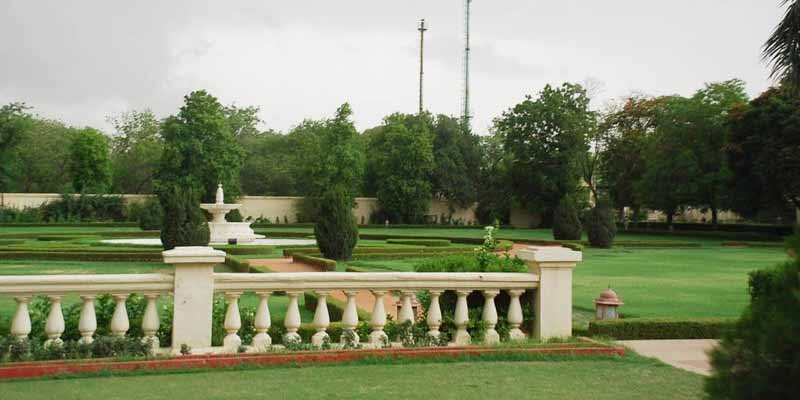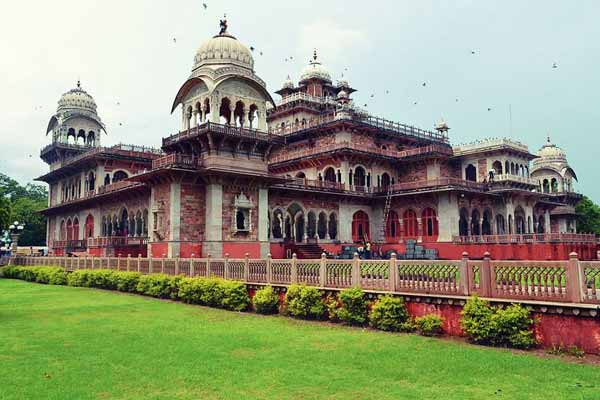Ram Niwas Garden Jaipur is a picturesque oasis located in the heart of Jaipur, Rajasthan, India. Spread over an area of approximately 33 acres, it is a verdant retreat that offers respite from the bustling city life. Established in 1868 by Maharaja Sawai Ram Singh II, this garden is a testament to the city’s rich cultural heritage and architectural prowess.
The garden is home to a diverse array of flora, including lush green lawns, vibrant flowerbeds, and towering trees that provide ample shade. It serves as a popular destination for both locals and tourists, offering a serene environment for leisurely strolls, picnics, and relaxation.
One of the prominent features of Ram Niwas Garden is the Albert Hall Museum, situated at its center. This grand edifice was designed by Sir Samuel Swinton Jacob and was completed in 1887 to commemorate the visit of the Prince of Wales to Jaipur. The museum houses a vast collection of artifacts, including exquisite sculptures, ancient coins, decorative arts, and historical manuscripts, providing visitors with a fascinating glimpse into the region’s rich cultural heritage.
In addition to the museum, the garden also boasts a bird park, a greenhouse, and a herbarium. The bird park is a sanctuary for various avian species, making it a delight for bird enthusiasts. The greenhouse showcases a wide variety of exotic plants and flowers, providing a captivating display of botanical diversity. The herbarium, on the other hand, is a treasure trove of dried plant specimens, serving as a valuable resource for botanical research Jaipur Tour Packages.
Ram Niwas Garden Jaipur is not only a place of natural beauty but also a hub of cultural and educational activities. It hosts numerous events, exhibitions, and cultural programs throughout the year, attracting art connoisseurs, history buffs, and nature lovers alike.
Overall, Ram Niwas Garden stands as a testament to Jaipur’s commitment to preserving its heritage and providing a tranquil haven for its residents and visitors to cherish and enjoy. It is a place where nature, history, and culture come together in perfect harmony, making it a must-visit destination for anyone exploring the vibrant city of Jaipur.

History of Ram Niwas Bagh Jaipur
Ram Niwas Bagh is a historic garden located in Jaipur, Rajasthan, India. It was built in the 19th century by Maharaja Sawai Ram Singh II, who was the ruler of Jaipur from 1835 to 1880. The garden was designed by Sir Samuel Swinton Jacob, a British architect, and it was named after the Maharaja himself.
The garden covers an area of approximately 33 acres and is situated in the heart of Jaipur city. It was initially designed to serve as a famine relief project during a period of drought, providing employment to local people while also creating a beautiful green space for the city of Jaipur.
Ram Niwas Bagh is known for its well-planned layout, which includes a central flowerbed, lush lawns, and a variety of trees and plants. One of the main attractions of the garden is the Albert Hall Museum, which is located at its center. The museum was designed by Sir Swinton Jacob and is named after King Edward VII (then Prince of Wales), who visited Jaipur in 1876. It is a fine example of Indo-Saracenic architecture and houses a diverse collection of artifacts, including sculptures, paintings, and decorative arts.
Over the years, Ram Niwas Bagh has become a popular spot for both locals and tourists alike. The garden provides a peaceful retreat from the hustle and bustle of the city, with its well-maintained pathways and shaded areas. It is also a popular destination for picnics, leisurely walks, and photography enthusiasts.
Today, Ram Niwas Garden Jaipur stands as a testament to the architectural and horticultural achievements of the past, and it continues to be an integral part of Jaipur’s cultural and historical heritage. It serves as a reminder of the vision and foresight of Maharaja Sawai Ram Singh II and the enduring beauty of this carefully crafted garden.
Attractions at Ram Niwas Garden Jaipur
Ram Niwas Garden in Jaipur, India, is a historical and well-maintained garden that offers a range of attractions and recreational facilities for visitors. Some of the notable attractions within the garden include:
Albert Hall Museum: Located within Ram Niwas Garden Jaipur, the Albert Hall Museum is one of the oldest museums in Rajasthan. It is known for its impressive Indo-Saracenic architecture and houses a diverse collection of art, artifacts, and exhibits, including paintings, sculptures, decorative arts, and more.
Zoological Garden: The garden also houses a small zoo that is home to various animals, including tigers, leopards, panthers, and a wide variety of bird species. It’s a popular spot for families and animal lovers.
Ravindra Rang Manch: This open-air theater within the garden hosts cultural events, performances, and programs, making it a hub for the arts and cultural activities in Jaipur.
Bird Watching: Ram Niwas Garden is a peaceful place to observe different species of birds, and it’s a favorite spot for birdwatchers.
Statues and Fountains: The garden features numerous statues, fountains, and sculptures, adding to its aesthetic appeal and providing great photo opportunities.
Beautiful Landscaping: The garden itself is beautifully landscaped with well-maintained lawns, flower beds, and pathways, making it a pleasant place for a leisurely walk or a picnic.
Temple: There is a small temple within the garden dedicated to Lord Shiva, which is an important religious site for devotees.
Children’s Play Area: There is a play area for children with swings, slides, and other recreational equipment, making it a family-friendly destination.
Art and Craft Bazaar: Occasionally, there are local art and craft bazaars organized in the garden, where you can shop for traditional Rajasthani handicrafts and souvenirs.
Ram Niwas Garden Jaipur is a popular spot for both tourists and locals, offering a blend of history, culture, and natural beauty. It’s a great place to spend some quality time while exploring the attractions it has to offer.
Best Time To Visit Ram Niwas Garden
The best time to visit Ram Niwas Garden Jaipur, India, largely depends on your weather preferences and what you’re looking to experience. Here are some considerations:
Winter (October to March): This is generally considered the best time to visit Jaipur, including Ram Niwas Garden. The weather is pleasant and mild, making it ideal for outdoor activities. The temperature ranges from around 10°C (50°F) to 25°C (77°F) during these months.
Spring (February to March): This is a particularly pleasant time to visit. The weather is still comfortable, and the garden is likely to be in full bloom with colorful flowers.
Monsoon (July to September): This is when Jaipur receives most of its rainfall. The garden looks lush and green during this time. However, heavy rainfall can sometimes disrupt travel plans, and the humidity levels can be quite high.
Summer (April to June): The summer months can get very hot in Jaipur, with temperatures often exceeding 40°C (104°F). Visiting during this time may not be as comfortable for outdoor activities.
Ultimately, the choice of when to visit depends on your personal preferences for weather and what you want to experience. If you prefer milder temperatures and lush greenery, the winter or monsoon months might be preferable. If you’re okay with heat and want to avoid the possibility of rain, the early spring might be ideal. Always check the local weather forecast before planning your visit to ensure the conditions align with your preferences.
How To Reach Ram Niwas Garden
Ram Niwas Garden is a popular tourist attraction located in Jaipur, Rajasthan, India. It is easily accessible by various modes of transportation. Here’s a brief guide on how to reach Ram Niwas Garden Jaipur:
By Air: The nearest airport to Jaipur is the Jaipur International Airport (JAI), which is approximately 11 kilometers away from Ram Niwas Garden. Upon landing, you can hire a taxi or use ride-sharing services to reach the garden. The journey should take around 20-30 minutes, depending on traffic conditions.
By Train: Jaipur Junction is the main railway station in Jaipur, and it is well-connected to major cities across India. From the railway station, Ram Niwas Garden is around 2 kilometers away. You can hire an auto-rickshaw, cycle rickshaw, or a taxi to reach the garden, which should take approximately 10-15 minutes.
By Bus: Jaipur has a well-developed network of buses that connect it to various parts of Rajasthan and neighboring states. If you are arriving by bus, you can get off at the Jaipur Bus Stand, also known as Sindhi Camp Bus Stand. From there, Ram Niwas Garden is approximately 4 kilometers away. You can hire a taxi, auto-rickshaw, or use a ride-sharing service to reach the garden, which should take around 15-20 minutes.
By Auto-rickshaw or Taxi: If you are already in Jaipur, you can easily hire an auto-rickshaw or taxi to reach Ram Niwas Garden. You can simply provide the name of the garden to the driver, and they will take you there. Make sure to confirm the fare with the driver before starting the journey.
By Walking: If you are staying in the vicinity of the garden, it might be possible to reach it on foot. This would be a convenient option if you are located within a few kilometers of Ram Niwas Garden.
Remember to check for any updates on transportation options, and consider traffic conditions, especially during peak hours. Additionally, it’s a good idea to have a map or GPS navigation on hand to ensure you reach Ram Niwas Garden Jaipur without any hassle.
